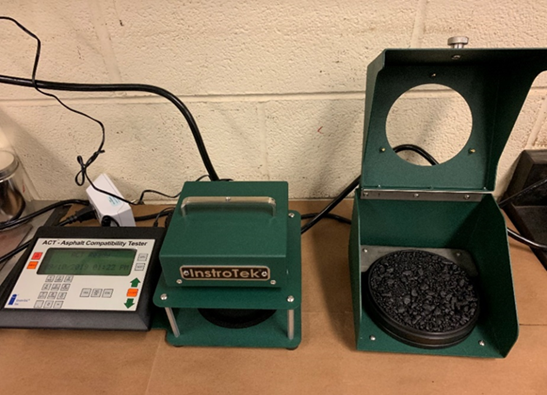The objectives of this project are to: (1) Establish a procedure to identify the optimum antistrip additive content for a given asphalt mixture and antistrip additive combination; (2) Evaluate the moisture damage resistance of plant-produced asphalt mixtures to establish a preliminary protocol for quality assurance and control; and (3) Develop an objective means to quantify emulsion-aggregate compatibility in lieu of the visual assessment procedure currently specified in NCDOT A-24 procedure. Laboratory-mixed, laboratory compacted mixtures were used to establish an antistrip dosage selection procedure for Boil test results coupled with Asphalt Compatibility Tester (ACT) color measurements.
Boil tests coupled with indices calculated from Asphalt Compatibility Tester (ACT) color measurements are correlated with Tensile Strength Ratio (TSR) test results. Limits for a moisture damage index calculated from Boil tests coupled with ACT measurements for laboratory-mixed samples to ensure a minimum TSR of 85 percent when using the NCDOT's modified AASHTO T 283 conditioning procedure were established that can be applied for antistrip dosage selection during asphalt mixture design. The limits could also be applied in lieu of TSR testing when there is a change in antistrip source or dosage if laboratory-mixed, laboratory-compacted samples are used.

Furthermore, interlaboratory testing suggests Boil tests coupled with ACT measurements generally yield reproducible results. However, a relationship Boil test results coupled with ACT measurements are not correlated with the TSR results of plant-mixed asphalt mixtures and therefore, the limits cannot be extended to quality control and quality assurance testing of plant-produced asphalt mixtures.
Five of the 11 plant-produced mixtures evaluated through TSR testing failed to meet the specified minimum limit of 85 percent when using the NCDOT's modified AASHTO T 283 conditioning procedure. Furthermore, six of the plant-produced mixtures failed to meet recommended TSR requirements when using the M.i.S.T. conditioning procedure. The NCDOT A-24 procedure coupled with ACT color measurements are effective in identifying poor compatibility in emulsion-aggregate blends, providing a potential means to remove the subjectivity of the current visual rating procedure. Criteria for identifying poor compatibility on the basis of ACT results were proposed. All field emulsion-aggregate blends evaluated that met these criteria also resulted in acceptable aggregate retention performance based on the Vialit test results of as-constructed chip seal samples. However, two aggregate-emulsion blends that failed to meet the criteria also resulted in acceptable Vialit aggregate retention test results, suggesting the preliminary limits may be overly stringent and require refinement.
